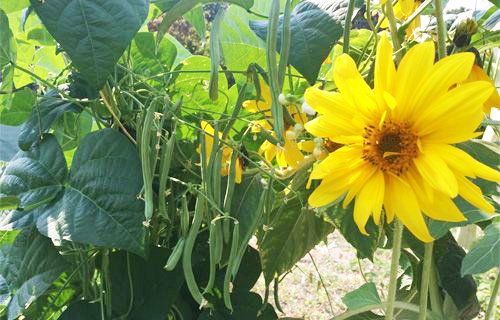Crafty Companion Gardening
by Ana Morlier
Spring has sprung, and it’s time to plan for the daunting task of deciding who gets a spot in the elite garden bed (or stays in a sad seed packet for who knows how many years). For more seasoned gardeners, I see you with your saffron and perfectly grown basil (puns intended). This article may be a tad repetitive for you. Just know that you can be proud of your Pinterest-worthy plants and that you are truly a pro in gardening. I humbly bow down in respect. For novices such as myself, companion gardening seems quite genius and explains why my plants have been, uh, not doing so well in the past. It’s time that my lonely (and only surviving) mint plants made nice and shared the garden bed. Below is a list of my recommendations for plant bed layouts, along with some nifty pest-repellent plants.
Pest-Repellent Plants
Get rid of bugs, attract the right pollinators, and offer a shade gradient for sun protection! Herb troubleshooting for getting rid of these pests:
Basil: Thrips, moths, armyworms. Attracts pollinators.
Dill: Ladybugs love it and get rid of your aphids and pesky spider mites
Garlic: Deters aphids, onion flies, moths, and Japanese beetles.
Mint: Aphids, ants, flea beetles. Grow at your own risk—it’s very greedy for land.
Sage: Carrot fly, moths.
Sunflowers: Pollinator, supportive for vines and other growers.
Tansy: Attracts both pest-killing insects (ladybugs, wasps) and deters cutworms.
Marigolds: Flower pollinator and all-around pest removal service.
Borage: Attracts bees, makes strawberries and tomatoes taste better.
Plotting the Plot: The Plot
All plants listed are warm-weather-loving plants (soil temperature minimum 50 degrees Fahrenheit), requiring 6-8 hours of sun. Make sure tall crops do not block pepper or tomato plants.
“Basil Pepper Pizza” Plot
Basil (loves water and mulch) is perfect for water retention. Peppers (I recommend bell, but try any variety of spicy pepper). Plant now! Early May is a great time to get started. You may need to plant (any type of) beans between the tomato and pepper plants to separate root systems and allow both to receive nutrients. Do not water from above, with only 1-2 inches of water per week. Tomatoes (early summer recommended). If buying from a nursery, you’ll want to avoid plants with flowers, fruit, or yellow leaves. Look for sturdy, dark green shoots. Purslane (great for keeping basil in shade, while making tomatoes and peppers taste better)! It’s also an edible leafy vegetable (despite claims of it being a weed).
“Cornucopia” Plot
Rosemary (natural insect repellent). Pole beans (enhance corn flavor through nitrogen control). Seedlings have weak roots and hate the cold and moisture, so plant outside and monitor carefully. Finally, have a trellis, teepee structure, or other support for this plant—it grows quickly and needs lots of (emotional) support, just like the rest of us. Squash (my favorite vegetable because it is super tasty sauteed, but it grows so well and is quite hearty). Must be a summer squash variety to eat with skin-on, which also includes yellow squash. Loves moisture! Corn (beans will climb up it in a greeting embrace). Strawberries (If you want to have a strawberry party at the end of the month, plant June-bearing varieties. A strawberry explosion all at once!). Day-neutral is your best bet for a continuous harvest. It won’t grow well in a plot that previously hosted tomatoes, peppers, or eggplants due to resentment from the last party.
“Garden Salad” Plot (Be ADAMANT about weeding! I take my all-uppercase words seriously)
Lettuce (keep soil moist but not soggy). It will certainly let you know that it is, in fact, not okay with wilting leaves (if too dry). It’s perfectly fine to water it any time of the day. Put in the shade of taller plants or shade cloth, so leaves don’t turn out bitter (due to bolting). Corn and tomatoes will be your friend on this one). Carrots (try not to plant in rocky soil for non-funky looking veggies). Sandy soil is best with lighter watering. Chard (cut when a foot tall, down to 3-5 inches, so it remains sweeter, if that can be said of this leafy vegetable). Make sure everyone gets a fair share of water because sharing is caring in your garden, in this case. Onions (plant marigolds with this one to offset pests). Let emerging onions breathe, but tiny immature guys can be covered with a bit of mulch. Mulch will let you off the hook for watering since it retains moisture well, so only one inch of water per week if you use this secret weapon. Another tip: More water makes onions sweeter and more nitrogen makes bulbs larger. Finally, tomatoes that are grown nearby can deter thrips from eating the fruits of your labor.
You can find many more pairings at the Old Farmer’s Almanac website (Search companion planting). The website also has an addicting little mobile game—I mean, an app, for planning your garden bed virtually (and maxing out your screen time for the day). You can enter in regional details, and the app will even plan out weather and pest patterns with lots of resources for planting and troubleshooting. You can also use Kitchen Garden Planner at Gardener’s Supply (website) and Garden Manager.
Lettuce commence planting season in this onion of flavors and vegetables. To purslane and beyond!

Sunflowers supporting their bean brethren.
Credit to: Credit to Catherine Boeckman and editing staff at Old Farmer’s Almanac, and Barbara Gillette of the Spruce.

